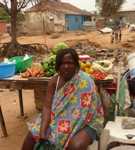ANGOLA: More Mothers Survive Childbirth
Louise Redvers
LUANDA, Sep 7 2010 (IPS) – As darkness falls on a cool evening in Luanda, a group of women sit huddled under threadbare blankets outside one of the city s few maternity hospitals. I have to be here, Paula Silva, 45, said, shivering slightly.

A new survey states that 36 percent of Angolans live in poverty – a significant reduction from the former World Bank estimate of two-thirds. Credit: Louise Redvers
Often they run out of medicine inside the hospital so we need to be here waiting so we can go to the pharmacy and get supplies, she explained. Silva s daughter was inside the hospital while Silva waited outside in case she got a message that they needed a medication (which was not in stock at the hospital) that she might need to buy at the pharmacy over the road.
I also have to take in some food (to her daugther), otherwise my daughter will get nothing to eat. The hospital has inadequate catering.
Silva gave birth to most of her children without any medical assistance. One was stillborn, and another died at six months. She is lucky to be alive after complications during her last pregnancy.
Nine years ago Silva may not have been so lucky. Preliminary results of a government study yet to be finalised, Inquerito Integrado Sobre o Bem Estar da Populacao (IBEP) or Well Being Survey, shows that both maternal and child mortality have decreased since 2001.
Angola, which lived through three decades of civil war that only ended in 2002, may be rich in oil and diamonds and have one of the fastest growing economies in Africa, but the country struggles to supply basics like water, sanitation and electricity to its people. And its social statistics make grim reading.
Related IPS Articles
However, the Well Being Survey shows that some progress is being made.
Compiled from interviews with 12,000 families across the country, it analyses results according to levels of education, age and sex and looks at the differences between life in rural and urban areas. It is the most comprehensive set of social statistics to be complied about Angola since 2001 (before the end of the war) and it has been welcomed by policy makers.
The report was compiled by Angola s Ministry of Planning and National Institute of Statistics, and supported by the United Nations Children s Fund (UNICEF) and the World Bank.
The good news of the survey showed that maternal mortality has fallen to 600 deaths in 100,000 live births, compared to 1,400 in the last count in 2001, and the overall child mortality rate is down to one in five from one in four.
According to the IBEP two-thirds of expectant mothers had at least one pre-natal consultation with a health attendant during their last pregnancy but less than 50 percent of births were in health facilities or attended by a qualified health worker.
In a bid to improve these figures and reduce mortality rates, a National Committee for the Prevention of Maternal and Peri-natal Deaths has been set up by government.
Local committees are to be set up around the country to analyse the reasons for maternal and infant deaths and to find practical means for their prevention.
However, Alcides Sakala, the spokesman for Angola s main opposition party UNITA (Union for the Total Independence of Angola), dismissed the campaign s launch as just another piece of propaganda. What we really need is to change the policies, and to change the policies, you need to change the people who are leading the country, he told IPS.
Elio Cotado, World Bank country manager for Angola, told IPS that the results of the study will help government target its interventions. He said the previous estimates used were based on assumptions that were in some cases outdated. I think these new results really will tell us the true story, so this is very welcome. It is also timely because we re in the process of designing a new country strategy with the government of Angola and this will help definitely help in terms of targeting our interventions.
Allan Cain, head of the NGO Development Workshop, which specialises in urban poverty issues, said the study was remarkable . He praised the government s honesty in reporting frank statistics like the fact that 90 percent of the urban population were living in unsuitable conditions and revealing the extent of the gap between the rich and the poor. According to the report the 20 percent of the most rich had an income which was 19 times that of the 20 percent most poor .
Hans Lunshof, Chief of Social Policy and Child Protection for UNICEF in Angola, added: It gives a clear indication about where the poverty is, the different poverty factors, therefore it will be very helpful in developing policies and implementing policies that better target the poorest and the most vulnerable.
The IBEP notes that just over 36 percent of the country live in poverty, although this figure is higher in rural areas around 58 percent. This is a significant reduction from the former World Bank estimate that two-thirds of Angolans live in poverty, the findings of which were similar to a recent study by the Catholic University of Angola. However, IBEP authors stressed they had used a new and different calculation method.
There have been significant improvements since 2001, the time of the last data collection. Some of the economic development has trickled down and we can see that from the results of this survey, Cain said, but added there remain big challenges ahead.
Codato told IPS that he believed there had been significant progress in the years of peace, but noted: I think Angola should be more demanding with itself in terms of using the wealth of the country and the endowment of natural resources for the benefit of its own people.